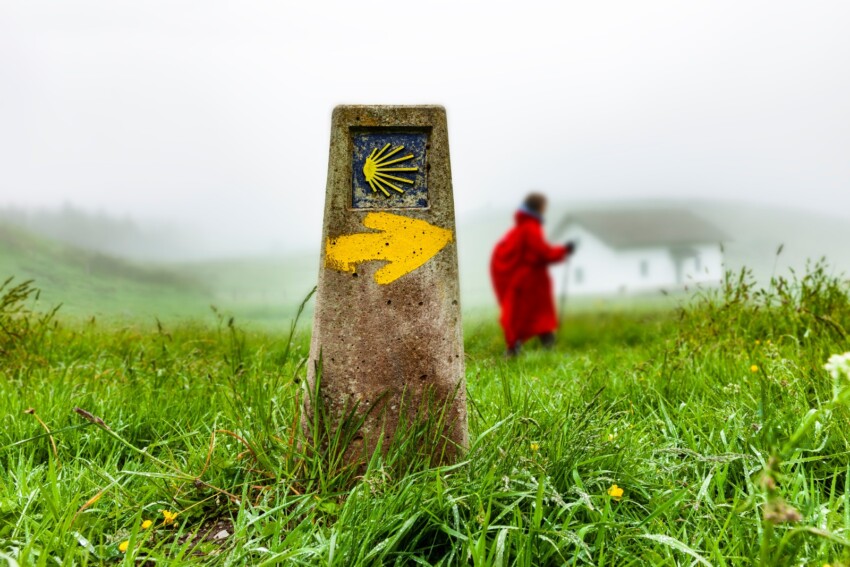

Originating in medieval times as a pilgrimage undertaken by the faithful from all over Europe to reach the cathedral that houses the tomb of the apostle James the Greater, the Camino de Santiago is today undertaken by people of all ages, social backgrounds, and physical levels for the most diverse reasons. It has become the most famous and most popular hiking route in the world.
For some, walking the Camino is still a deeply religious experience, for others it is a spiritual experience not linked to a traditional religion, a desire to get out of their comfort zone and put themselves to the test, or simply a hiking route through some of the most beautiful landscapes in Spain (but also in Portugal and France).
For everyone, this long journey on foot with a thousand meanings is a life-changing experience. Although it is an experience suitable for everyone, the physical and psychic effort is high: it involves walking every day for a long time, which can lead to fatigue, blisters, muscular pains and tendinitis, and facing inevitable moments of loneliness. Everyone experiences a moment of despondency during the Camino, but it is precisely these moments that bring out unexpected energy and resources in people, which is why the Camino is an experience that profoundly changes people.
Contrary to what is commonly believed, there is no single itinerary: in the past, pilgrims arrived at Santiago de Compostela along different routes, which today are referred to as ‘the Caminos‘. The most famous ones are the French and the northern routes. Both cross Spain from east to west, touching the central and northern regions in the first case and the regions washed by the ocean in the second.
Here you will find all useful information on the Pilgrim’s Way to Santiago: rituals linked to the Way, the four most famous routes, stages and distances, practical advice. Follow the concha and buen camino!
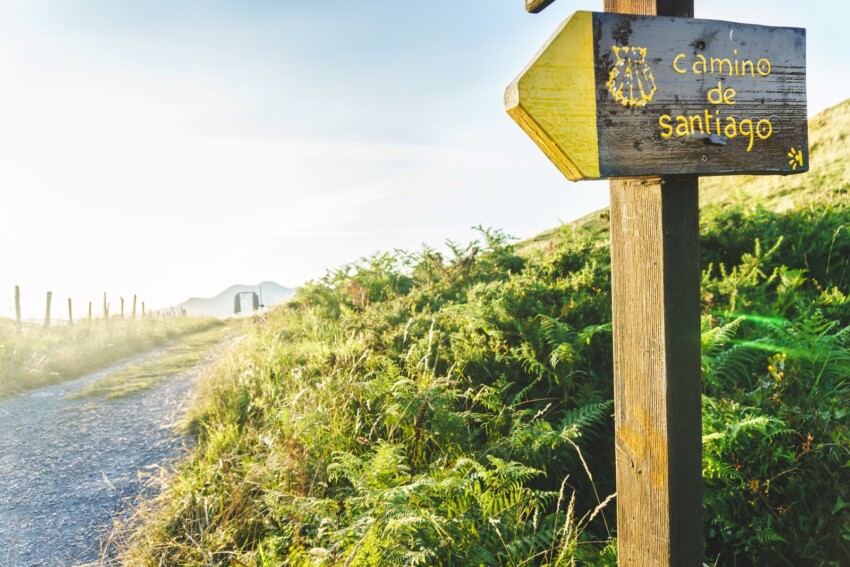
Even today there are many rituals and symbols linked to the Pilgrim’s Way to Santiago. One of these is the concha. In the past, it was the object that pilgrims received on their arrival in Santiago de Compostela, while today those who undertake the route wear one from the first stage by attaching it to their clothes, backpack or walking stick as a kind of protective amulet. The concha is also one of the signs that show the way to the pilgrim, along with the yellow signs.
Don’t forget to ask for the pilgrim’ s credential, which is necessary to have access to the inexpensive pilgrim’s hostels and to obtain the Compostela, the official certificate issued by the Cathedral of Santiago to those who have walked, cycled or ridden at least 100 km along one of the routes.
The Camino de Santiago has given a considerable impetus to the development of tourism in north-central Spain and many private hotels have sprung up on many stretches.
However, to keep costs down and to fully enjoy the experience of the Pilgrim’s Way, it is advisable to sleep in the albergues, hostels run by the parish or the municipality: not only are they much cheaper than a b&b, but they allow you to meet other people who are having the same experience and to exchange useful information and advice. Moreover, in the hostels, a community dinner is often consumed, a nice way to socialise and experience a convivial atmosphere of yesteryear.
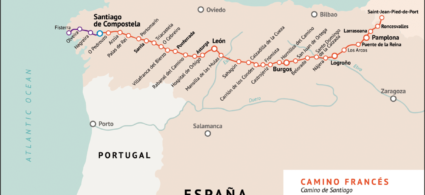
The French Way is the ‘classic’ one, chosen by most pilgrims and walkers, which runs from the Pyrenees to Santiago de Compostela, crossing the regions of north-central Spain from east to west. As its name suggests, this route starts on French territory, although it already leaves France at the end of the first stage.
The reason for its popularity compared to other paths is a mixture of charm and comfort. Along the French route, you will cross very different landscapes: the peaks of the Pyrenees, the fertile Ebro valley, the vineyard-covered hills of La Rioja, the endless (sometimes torrid!) plains of central Spain and the green landscapes of Galicia, so reminiscent of northern European countries.
As it is the most travelled route, it is also the one that is best signposted and with the greatest number of albergues and private hotels. By choosing this route, it is not necessary to book the albergue in advance: a place to sleep can always be found (a few more difficulties in July and August); moreover, you are almost certain to meet other people along the way, which is useful both in the event of any difficulties and to enrich your experience with the stories of other pilgrims and hikers.
In addition, this route has few differences in altitude and is therefore the easiest.
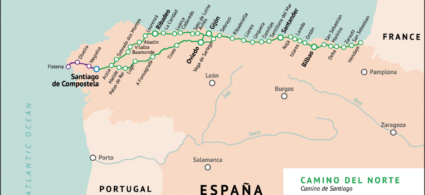
The Northern Pilgrim’s Way is the oldest of the paths leading to Santiago because it stretches along territories that at the time when pilgrimages in the name of St James began were already controlled by Christian kings (unlike the territories of the French Way, which were controlled by the Arabs) and therefore safer. In addition, pilgrims from northern Europe could reach the start of the route by ship.
The route runs roughly parallel to the northern coast of Spain, from east to west. The landscapes are very different from those of the French Route, but again there is great variety. Many people choose this route because they cannot resist the allure of the ocean and indeed walking along the coast is very impressive.
Another advantage of this route is that, compared to the French one, it touches on larger towns, especially in the first section within the Pais Vasco, and thus allows you to combine the spiritual experience of the Camino with some ‘simple’ tourism.
You will find fewer people on this route than on the French Way, nevertheless the Camino del Norte remains one of the most popular. The main difference between the French Way and the Northern Way is that the latter has a greater number of gradients. These are not large inclines, but continuous climbs that overall make it more strenuous than the French Way. For this reason it is generally divided into shorter stages.
The number of albergues is also smaller: it is good to keep this in mind, although there are generally no difficulties in finding places to sleep.
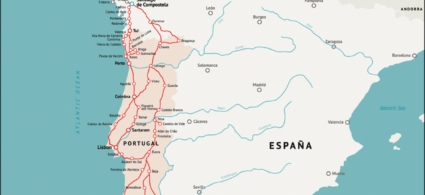
A little-known path until a few years ago but one that is steadily growing in popularity is the Portuguese Way, an alternative to the ‘classic’ paths for those who prefer Portugal to Spain or for those who love both countries and want to combine them in a single experience!
The starting point of the Portuguese Way is the city of Lisbon, although most pilgrims and walkers choose to begin in Porto, and ascend from south to north to Santiago. In some sections the route runs parallel to the coast, allowing for breathtakingly beautiful beaches and cliffs overlooking the ocean, but for the most part it runs inland. There is a coastal variant for those who do not want to leave the ocean; another well-known variant leads to the city of Fatima.
It is fairly easy to follow, but keep in mind that the Portuguese Way is less organised than those in northern Spain. The signposting is not always accurate and there are few albergues, especially on the stretch from Lisbon to Porto. It must be said, however, that given the ever-increasing number of people choosing the Portuguese rather than the northern or French Camino, it is possible that the situation will change in a short time.
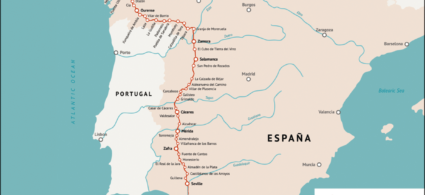
There is also a fascinating route that starts in Seville, in the southernmost region of Spain (Andalusia), and goes up to Santiago de Compostela: it is called the Via de la Plata, a route that retraces an ancient Roman road.
Of all the Caminos de Santiago, it is the longest (almost 1000 km, about 200 more than the French Way), the least equipped (few albergues along the route) and the loneliest.
Due to its length, the scarce availability of hotel facilities and the small size of the villages crossed, which often lack services, it requires good organisation. As it is little travelled, you might not meet anyone for many kilometres and it is therefore advisable to do it in the company of another person, who can help in case of difficulty; on the other hand, it is precisely this lack of crowding that makes it an experience more similar to that of pilgrims of the past.
The Camino de Santiago is an experience within everyone’s reach. You are not tackling high-altitude paths that present a number of difficulties and risks: it is a walk that anyone can do, without special knowledge or experience. If you think that 800 km is too much for you or you cannot take a long holiday, you can always do part of it and perhaps complete the route on one or more subsequent occasions.
If you are already a hiker, you will have no problem doing the Pilgrim’s Way to Santiago; if not, a little preparation in the preceding months is necessary. Start with short walks and gradually increase the length of the route. Remember that the main difficulty of the route is not so much the length of the individual stages but the fact that you will be walking every day. It is therefore important to be consistent in your training: better small distances but with regularity than large distances occasionally.
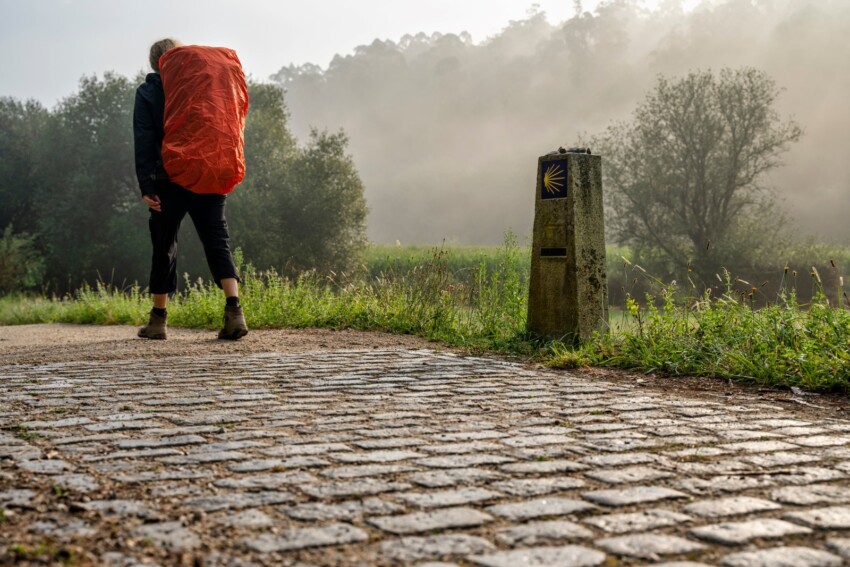
The division into stages that we have given you for the various walks is a classic division, followed by many people, but it is not exhaustive. In fact, there is no ‘rulebook’ whereby you absolutely must follow a set itinerary that takes you from this to that country every day. Everyone chooses the starting and finishing point of each stage according to their physical capabilities, their pace and the physical conditions on that day.
There are many possible detours and each person can freely create his or her own route. Sometimes the detours make it possible to shorten the route and thus come to the aid of those who are very tired. Sometimes they are worth extending to see a particularly beautiful panorama. Other times they serve to avoid walking along the road. In short, there is no ‘one’ Path: everyone creates their own!
By now accustomed to the use of mobile phones with Google Maps and GPS, one would think that these tools would be sufficient in case of doubt as to which route to follow.
In reality, we would advise against their use, both because there may be no internet connection at some points along the route and because you would lose the components that make the Camino a unique experience: forgetting the rhythms and habits of everyday life, returning to savour simple gestures such as eating and sleeping and, above all, being ready to embrace any situation that may arise along the way. It is therefore better to prepare in advance and, if necessary, bring a map or a paper guidebook: their old-fashioned charm is perfectly in line with the spirit of the Camino.
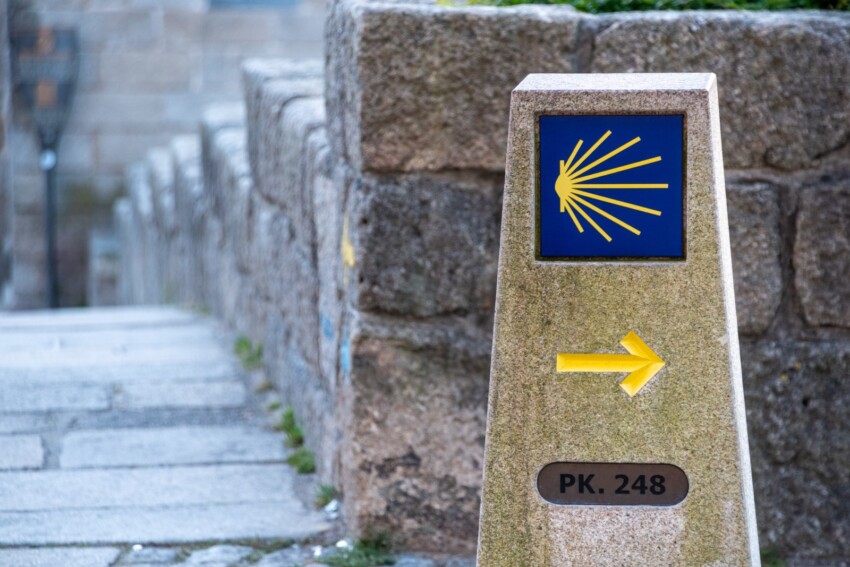
Other things to keep in mind
There are three main routes with different characteristics and lengths: the French Way, the most traditional and popular, stretches 900 kilometres through varied landscapes and historic cities of northern Spain. The Northern Way covers 800 kilometres along the Cantabrian coast, offering spectacular ocean views and a more temperate climate during the summer. The Primitive Way, considered to be the original pilgrimage route, covers 300 kilometres through the picturesque regions of Asturias and Galicia, with a more challenging but historically rich route.
The duration of the pilgrimage varies significantly depending on the route chosen and one’s own pace. Generally, one needs 7-8 days to walk 200 kilometres, which is the minimum distance to obtain the Compostela. It takes 30-35 days to complete the French Way, calculating an average of 25 kilometres per day and including a few rest days to visit the main cities or recover energy. Experience shows that it is better not to be in a hurry, allowing time to savour the unique atmosphere of the places crossed.
The Compostela is the official certificate issued by the Cathedral of Santiago certifying the completion of the pilgrimage. To obtain it, spiritual or religious motivation is required, not merely tourist or sporting motivation. Pilgrims must complete the last 100 kilometres on foot or on horseback, which becomes 200 for those travelling by bicycle. Certification is done through the pilgrim’s credential, a document that must be stamped at least twice a day at authorised facilities such as hostels, parishes, tourist offices or Camino associations. These stamps not only certify the route but also become a precious memento of the journey.
The choice of period depends on several climatic and logistical factors. Spring offers ideal conditions with mild temperatures, blooming landscapes and days long enough for walking. The autumn period between September and October is equally favourable, with pleasant temperatures and fewer crowds than in summer. The summer months, although popular, require dawn departures to avoid the intense heat, especially in the Castilian Meseta. Winter offers a more solitary and contemplative experience, but requires adequate equipment to cope with cold and rain.
The Camino is perfectly safe for solo travellers, thanks to an established support network and the constant presence of other pilgrims. The regular influx of walkers, the availability of numerous hostels and assistance points, and the strong sense of community also make the route ideal for solo travellers. Small groups often form spontaneously with other pilgrims proceeding at the same pace, allowing them to share the experience while maintaining the freedom to walk at their own pace.
The daily stages are typically 20-30 kilometres, but this distance is easily adaptable to one’s abilities and preferences. It is advisable to start the walk early in the morning to allow sufficient time for stops and to arrive at your destination before sunset. The flexibility of the route allows the stages to be modified according to tiredness, weather conditions or the desire to explore certain locations. Many pilgrims choose to alternate more demanding days with shorter stages to better manage their energy.
The route is marked with the iconic yellow arrows on walls, ground, trees and dedicated signs. This historical signposting is very reliable and constantly maintained by local associations. As additional support, it is advisable to carry a printed guidebook or a dedicated app, which are also useful tools for identifying points of interest, hostels and services along the route. The local population has a long tradition of welcoming pilgrims and always offers precise directions in case of doubt.
Preliminary training in the months preceding departure is essential. Preparation should include progressive walks of increasing length, using the same shoes that one will wear on the pilgrimage. This allows the body to gradually adapt to the effort and to identify any problems with the equipment. It is advisable to start with short walks, progressively increasing distance and difficulty, possibly with a loaded backpack to simulate the real conditions of the Camino.
The ideal backpack has a capacity of 35-40 litres, should be anatomical and have adjustable straps to distribute the weight correctly. The total load should not exceed 7 kg, representing a maximum of 10% of the pilgrim’s body weight. Essential equipment includes technical and breathable clothing, a complete change of clothes, a first-aid kit for blisters and minor injuries, personal documents, a sleeping bag for hostels, personal hygiene material and a large water bottle. It is essential to choose lightweight, multifunctional materials to optimise weight.
The Camino offers a variety of accommodation for all needs. Public hostels are the cheapest and most authentic option, followed by private hostels with additional services. For those seeking more comfort, there are farmhouses, hotels and the prestigious Paradores, old historic buildings converted into accommodation facilities. The choice of accommodation greatly influences the pilgrimage experience: hostels encourage socialisation and community spirit, while private facilities offer more privacy and services.
Hostels follow precise rules designed for the flow of pilgrims: they generally open at 12:00 noon, impose silence from 9:00 p.m. and require check-out by 8:00 a.m. They do not accept advance bookings, assigning places in order of arrival with priority to pilgrims on foot. Public hostels are free or very inexpensive, while private ones offer additional services such as laundry, cooking and Wi-Fi at prices that are nevertheless moderate. Some also provide breakfast or have communal kitchens for pilgrims.
A correct diet is essential to face the Camino. The day should start with a hearty breakfast rich in carbohydrates and proteins. During the walk, it is important to maintain constant hydration and to have regular snacks with dried fruit, energy bars or fresh fruit. Most establishments along the route offer the ‘pilgrim’s menu’, a complete meal at an agreed price that provides the calories needed for physical exertion. It is advisable to always carry some energy snacks for the stretches where services are more distant.